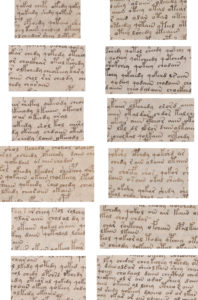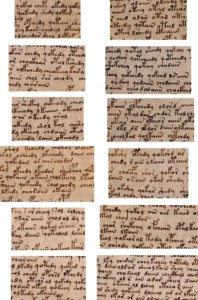In a recent post, I discussed a large number of features of the Voynich Manuscript’s Quire 20, to try to get under its vellum skin (so to speak). One thing I’d add is that if you compare the vellum colour of the front (recto) and back (verso) of pages f103 through to f108…
…you can see (I think) if you constrast enhance these…
…that f104, f105, f107 and f108 appear to match each other quite well.
Hence – given that I think f103 may well be separate anyway – I infer from this that f104, f105, f107 and f108 may well have been folded and cut from a single piece of vellum: and hence that they might very well have sat next to each other in Q20’s alpha state. Hence f106 and the missing f109-f110 bifolio may well have been from a different piece of vellum, and so (given that I suspect f105r was the first page of the book hidden in the quire) may well together have formed the two most central bifolios of the quire.
So: given all the above, and that there seems to be a good chance that f108v and f104r originally sat next to each other (as discussed before), I suspect we now know enough to reduce the large list of bifolio permutations for Q20’s original state down to just four good candidates (I’ve only listed the first folio of each bifolio pair for convenience):
a) f103 : f105 f108 f104 f107 f106 [f109]
b) f103 : f105 f108 f104 f107 [f109] f106
c) f103 : f105 f107 f108 f104 f106 [f109]
d) f103 : f105 f107 f108 f104 [f109] f106
Of course, I may be wrong… but I do now think there’s a high chance that this is basically correct.
But to use the block-paradigm trick (i.e. to decrypt a cipher by finding a separate copy of the text from which it came) with these possible candidates, though, we need to also find a structurally matching copy of the hidden book’s plaintext.
So the big question is surely this: how on earth do we find a copy of Quire 20’s plaintext?
Johannes Alcherius
Elsewhere in Cipher Mysteries, I mentioned BNF MS Latin 6741, which is a collection of 359 recipes collected together in Paris by Jean le Bègue / Jehan le Bègue in 1431, and which was discussed by Mary Merrifield in her 1849 book Original Treatises, Dating from the XIIth to the XVIIIth Centuries, on the Arts of Painting.
Yet having now read in rather more depth about Jean le Bègue’s recipe collection here, I suspect that the answer lies not in Paris (the city which BNF MS Latin 6741 seems never to have left) but instead in Milan, and specifically with Johannes Alcherius – arguably the key author whose recipes Jean le Bègue ripped off collected together.
However, the big problem is that while Alcherius wrote in Italian, Jean le Bègue wrote in Latin – so what we have in BNF MS Latin 6741 is actually a Latin translation of Alcherius’ Italian original.
So if I’m right about this, it would mean – unfortunately – that rather than finding the Italian plaintext from which I believe a large part of Quire 20 was derived, I strongly suspect that BNF MS Latin 6741 instead contains Jean le Bègue’s Latin translation of that same Italian plaintext.
So… even though I suspect that the block paradigm trick may have got me close to the finishing line in this instance, the Voynich Manuscript’s secrets still continue to elude us. Close, but no cigar. Or pizza. Oh well! 🙁
How to cross the Quire 20 line?
It seems to me that the single most important piece missing from this jigsaw is the Italian plaintext of Johannes Alcherius’ recipes for colours. I can see two possible routes to achieve this:
(1) Reverse translate Jean le Bègue’s Latin back into the Italian plaintext from which it was derived. Which would be exquisitely nuanced, and very hard to get right, but just about possible all the same. Or…
(2) Find fragments of Alcherius’ recipes floating in other documents, but in their original Italian form (rather than in Jean le Bègue’s Latin translation). It may be that, somewhere in the far recesses of Academe, someone has already searched for this, perhaps as part of a compeletely separate study. But if so, my own digging has been utterly unable to find it.
Perhaps you will have better luck, though!
Things you can help with
Does someone have (or can get access to) a PDF copy of “The recipe collection of Johannes Alcherius and the painting materials used in manuscript illumination in France and Northern Italy, c. 1380-1420” (1998) by Nancy Turner that they can send me, before I start throwing my money at Maney Online (now part of Taylor & Francis)?
Or a copy of “Painting Techniques : History, Materials and Studio Techniques, Proceeding of the IIC Dublin Congress, 7-11 December 1998”, where the same thing also seems to appear?
Or… does anyone have a study listing all pre-1500 Italian colour recipe manuscript fragments? (For what it’s worth, I was unable to find any mention of Alcherius or Jean le Bègue in Thorndike.)


Nick: Not too long ago I tried to catch your attention with a very small (but thorough) book which addressed and portrayed nearly all “The Colors of the New World — Artists, Materials, and the Creation of the Florentine Codex” There is discussion in re The Twelve Books of the Florentine Codex / Images and Texts Between Two Worlds – The Paintings: Objects or Subjects, Painting and Knowledge in Tlilli in Tlapalli, Toltecye and the Nahua Treatise on Painting . There are illustrated discussions of obtaining and producing nocheztli (cochineal) , quiltic (Maya Green), where the tlacuilo (painter)produces “. The writer of this small book suggests ‘a long tradition of illuminated manuscripts from the time of the Middle Ages —Just as Pliny presented the followers of Appelles –heirs to the great tradition ‘in tlilli in tlapalli’ (figure 8 in this very small, concise, and very illustrative book.
Two items of particular interest to me was discussion of medieval paintings use of cinnabar and minium (red lead) — with further reference that those small paintings (both in New World and Old World” were called ‘miniatures (from miniare in Latin, which means “to color with red”.
Kerpel also discusses the Native “miniature” of Moctezuma dead in the waters of the Grand Canal : top half is in full colors and bottom half pale shades of gray and yellow.
Please, Nick, find a copy of this small booklet in which Professor Kerpel and
Cuahtemoc Medina (Head curator (MUAC) at UNAM. (Getty Research Institute Council Lecture)
Hi Nick,
I don’t have academic access to the supplement containing Turner’s article for some reason, but I think the State Library may hold a copy – I’ll check it out while I’m at lunch and let you know.
I do have access to another article by Turner in the same journal – ‘Technical Examination of a Fifteenth-Century German Illuminated Manuscript on Paper: A Case Study on the Identification of Materials’. If that’s of any interest, I can forward you a copy.
The State Library has been looking for the book with Turner’s paper in for me, but unfortunately it has gone missing. I think you may have to shell out for the PDF if no-one else has managed to get you a copy.